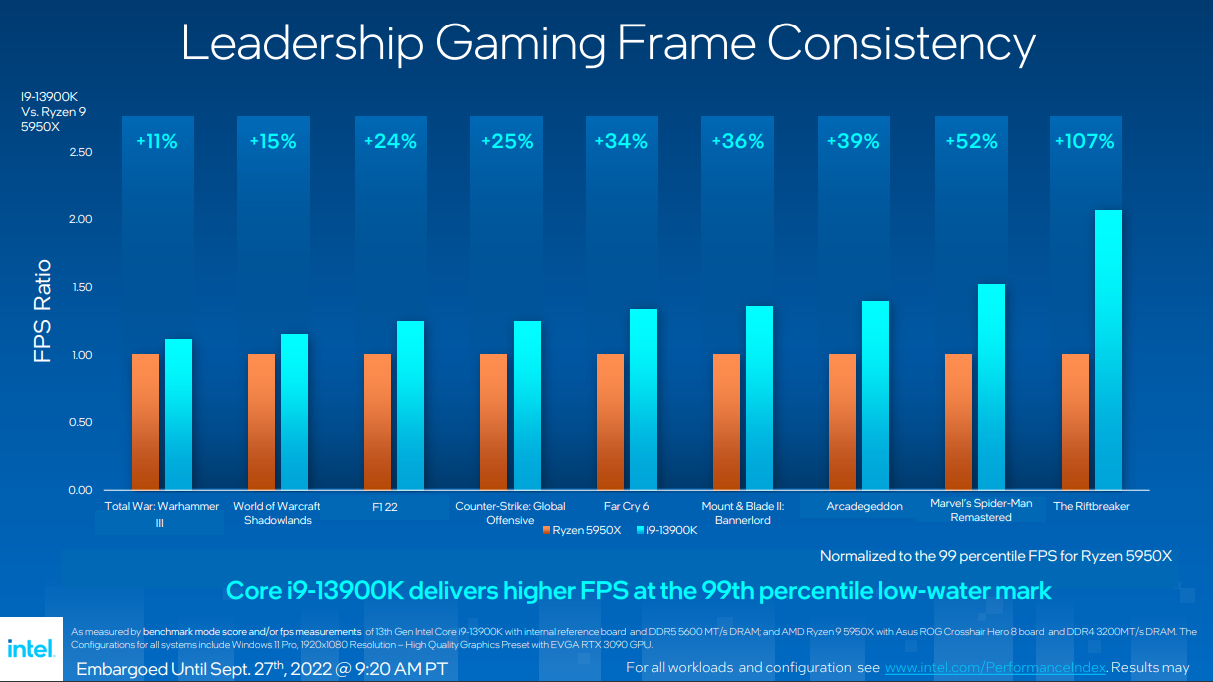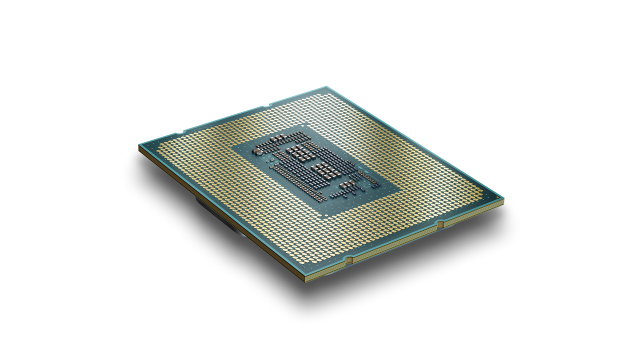AMD hasn’t had more than a day since it launched what it’s claiming are the world’s new fastest gaming processors, and Intel’s already firing back with specs, a release date, and big claims for its 13th generation of desktop CPUs, which it also claims are the world’s fastest. Speaking at “Intel Innovation” today, CEO Pat Gelsinger officially detailed Intel’s Raptor Lake Core i5, Core i7, and Core i9 chips.
Pricing
Let’s start with perhaps the most impressive part of the package, which is its pricing. Intel’s new chips start at $US294 (prices are still based on US figures but we will update once we find out Aussie specs) for the i5-13600KF and run up to $US589 for the i9-13900K. That puts even the line’s (currently) most expensive chip well below AMD’s new flagship, the $US699 Ryzen 9 7950X. It also means that the Core i5 is the only chip to have been bumped up in price, despite a prior warning that there would be more. But Intel’s value proposition doesn’t end there.
That’s because Intel’s new chips are going to be far more compatible with existing parts than AMD’s offerings. While AMD’s Ryzen 7000 series will require you to buy all-new motherboards, plus invest in still-expensive DDR5 RAM, Intel’s 13th gen will work with existing Intel 600 series motherboards and will continue to support DDR4 RAM. That makes it a lot easier to upgrade an existing machine without having to replace a bunch of your parts, even if it means you won’t necessarily get the most out of your new chip.
Specs
Topping out at $US589 doesn’t mean much if Intel can’t keep up with AMD’s flagship, though. This is where the new chips’ specs come in. We’ve got a detailed table down below, but the key takeaway is that, while Intel hasn’t given its chips more P-cores (for power-hungry tasks), they all have more E-cores, which will help with multitasking and multithreaded apps. The Core i5 and Core i7 have four more E-cores each, while the Core i9 has eight more E-cores.
You might have noticed base frequencies are down while boost frequencies are up. That might sound like a scary stat, but processor “speed” is actually misleading, and only tells part of the story. AMD’s only just crossed the 5 GHz threshold, and yet has been keeping pace with Intel for a few generations now. While frequency does tell you how fast your chip can finish a calculation, it doesn’t tell you how many calculations a chip can perform at once, or how quickly it can gather and store data from other components– that has to do with core count and cache, both of which are up from the last generation.
PCIe gen 5 support also aids in performance, as it allows your computer’s components to communicate more quickly. To take advantage of the 13th Gen chips’ 16 lanes of it, you’ll have to invest in either an existing 600 series or the upcoming 700 series motherboard that supports it — not all do. 700 series motherboards will also come with eight additional PCIe 4 support lanes and one extra USB 3.2 Gen 2×2 (20 Fbps) slot.
While pricing has remained roughly the same as Intel’s prior generation, there is one new cost you’ll have to account for: power draw. While base power draw is at a respectable 125 W, the Core i7 and Core i9 now require 243 W for max turbo power, while the Core i5 needs 181 W. While that’s a negligible difference for the Core i9, which used to require 241 W, Core i7 and Core i5 users will need to plan their power supply upgrades accordingly. The Core i7 used to hit max turbo power with 190 W, while the Core i5 used to hit it with 117 W.
So, what kind of performance increases could you get with these new chips? Intel’s been generous with its in-house benchmark claims, although you’ll want to take these with a grain of salt, especially since we don’t know any details about the system the company used for testing aside from the processor.
In general, the company’s promising “15% better single-threaded performance and 41% better multi-threaded performance” over the last generation, which it says translates to “up to 24% better gaming performance” and “34% faster creator workflow.”

For a few examples, Marvel’s Spider-Man Remastered running with the Core i9-13900K supposedly had a 52% increase in frames over the Ryzen 9 5950X, while Far Cry 6 had what Intel claims was a 34% increase. Pugetbench’s Adobe Premiere Pro benchmark supposedly scored 16% higher with the same equipment, while its Adobe Photoshop benchmark had a seeming 33% higher score.
Release Date
Those numbers certainly look competitive with the new middle-of-the-pack AMD chips we reviewed just yesterday, and we’re excited to verify them ourselves when we get Intel’s Raptor Lake chips in hand. As for when you’ll be able to get them, Intel’s Core i5, Core i7, and Core i9 13th gen desktop chips will hit the market on October 20 alongside Z790 motherboards. Intel’s also promised more chips in the future, including one that will breach the 6 GHz barrier.
Prices are based on US dollars but will be updated to Australian dollars once the products are released here.
